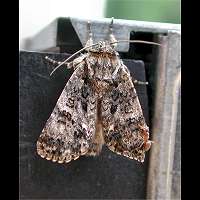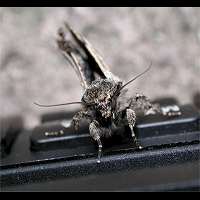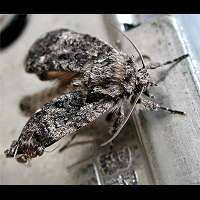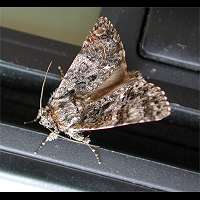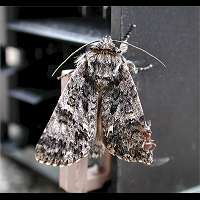Knot Grass Acronicta rumicis
The Knot Grass is a medium-sized, slightly variable Noctuid. Usually well marked, but less marked and very dark animals also appear regularly, some almost black. The best way of identifying this species is to look voor the white spot near the trailing edge of the forewing at about three quarters from the base of the wing. This spot, sometimes there are two, is usually visible even in the darkest animals. The pictures on this page are not very usable in that respect, for this is an animal that just got out of its cocoon. Most animals are slightly darker and less well marked. The wingspan is some 34 to 44 mm.
The first eggs are deposited by the end of May. They hatch after just one week and the caterpillars grow very quickly. In England there is light and time enough to produce two generations. The last eggs are deposited in August. By the end of September the caterpillars pupate to overwinter. They spin een parchment-like cocoon. This is composed of not only threads, but of bodily hairs as well. The cocoon is made on the ground in leaf litter regularly, but also just above the ground in low growing plants. The caterpillars are colourful and very hairy, an exception among the Noctuids. The basic colour is brown or black. On the back the caterpillar has white spots and groups of brown hairs. Along the sides runs a red line interrupted by white spots. On it we see bundles of brown hairs as well. The spiracula are visible as clear small white spots, just above the colourful line. The caterpillar of the Knot Grass reaches a length of some 35 to 40 mm. The larvae feed on a great variety of plants, such as low growing Broad-leaved Dock and Water Mint, higher growing plants, such as thistles and hop, shrubs, including bramble and Hawthorn and trees, especially sallows. In gardens sometimes found eating roses.
In Southern Britain double brooded and on the wing May-June and August-mid September. From the Midlands northwards there is only one generation, on the wing in June and July mainly. The Knot Grass flies about during the night only, but is attracted to flowers, sugar and light. Visits gardens regularly. Common in England and Ireland, less common in Wales and the Scottish lowlands, rare in Northern Scotland and the highlands. Not reported from Orkney or Shetland. Very common on the continent too. South of Britain usually in three generations a year. Getting scarcer northwards in Scandinavia.
The Knot Grass is a medium-sized, slightly variable Noctuid. Usually well marked, but less marked and very dark animals also appear regularly, some almost black. The best way of identifying this species is to look voor the white spot near the trailing edge of the forewing at about three quarters from the base of the wing. This spot, sometimes there are two, is usually visible even in the darkest animals. The pictures on this page are not very usable in that respect, for this is an animal that just got out of its cocoon. Most animals are slightly darker and less well marked. The wingspan is some 34 to 44 mm.
The first eggs are deposited by the end of May. They hatch after just one week and the caterpillars grow very quickly. In England there is light and time enough to produce two generations. The last eggs are deposited in August. By the end of September the caterpillars pupate to overwinter. They spin een parchment-like cocoon. This is composed of not only threads, but of bodily hairs as well. The cocoon is made on the ground in leaf litter regularly, but also just above the ground in low growing plants. The caterpillars are colourful and very hairy, an exception among the Noctuids. The basic colour is brown or black. On the back the caterpillar has white spots and groups of brown hairs. Along the sides runs a red line interrupted by white spots. On it we see bundles of brown hairs as well. The spiracula are visible as clear small white spots, just above the colourful line. The caterpillar of the Knot Grass reaches a length of some 35 to 40 mm. The larvae feed on a great variety of plants, such as low growing Broad-leaved Dock and Water Mint, higher growing plants, such as thistles and hop, shrubs, including bramble and Hawthorn and trees, especially sallows. In gardens sometimes found eating roses.
In Southern Britain double brooded and on the wing May-June and August-mid September. From the Midlands northwards there is only one generation, on the wing in June and July mainly. The Knot Grass flies about during the night only, but is attracted to flowers, sugar and light. Visits gardens regularly. Common in England and Ireland, less common in Wales and the Scottish lowlands, rare in Northern Scotland and the highlands. Not reported from Orkney or Shetland. Very common on the continent too. South of Britain usually in three generations a year. Getting scarcer northwards in Scandinavia.

